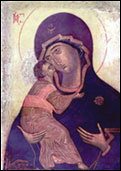 |
 |
|
 |
 |
|
The Icons of the Mother of God
|
|
The icon is not a portrait or a picture. It is a likeness of a divine, heavenly appearance, and we pray not to the icons themselves, but through them we reach the depicted Prototype. For this reason there is nothing worldly or carnal in icons, and their forms reveal to us the mystery of the invisible, divine world. It is not faces, but images that look out at us from icons, and the profound gaze of these images imparts to them an expression of strict yet kindly repose and a grief devoid of pain, both alien to worldly vanity. Artistic perspective has no place in an icon. Nature and architectural details are depicted in it to intensify movement and the expression of emotion. The icon truly becomes an icon only through consecration. Through consecration the impassable boundary between a religious picture, however lofty its religious content and artistic merit, and an icon, however modest it is in this regard, is crossed. The consecration of an icon with holy water imparts to it the grace of the Holy Spirit, which is revealed in certain icons in the form of a special mercy of God – their miraculous nature. Iconographers were usually monks, and they approached their work with prayer and fasting. Icons are not signed by the iconographer, since they are painted not for personal glory, but for the glory of God.
|
Icons of the Mother of God are of three types:
|
|
1) The Eleousa (Merciful, Compassionate). This form arose in Byzantium in the 11th century, and conveys an affectionate relationship between the Infant and His Mother, Who foresees the sufferings that await Him. The divine Infant’s cheek touches that of the Mother of God Who, inclining Her head, supports the Infant Who movingly encircles Her neck with His arm. (The Vladimir and the Feodorovskaya icons are of this type.)
|

The "Vladimir" Mother of God.
Andrei Rublev. 1408. |

The Iveron Mother of God |
2) The Hodigitria (the Guide). According to tradition this icon was painted by the Evangelist Luke and sent by Empress Eudocia (399-453) to Constantinople. In this icon the divine Infant is held in the arms of His Mother, yet does not touch Her cheek, but sits a little withdrawn, gazing out before Him. The Theotokos points to the Infant Saviour (the Way) with Her right hand, and Christ holds a scroll in His left hand, while with His right hand He conveys His divine blessing. (The Kazan, Tikhvin, Smolensk and Iveron icons are of this type.)
|
|
3) The Orans (the Virgin of the Sign). In this type of icon the Mother of God is depicted with upraised arms, the preeternal Infant in Her womb. Here the depiction of the Mother of God is frontal, half-figure or full-figure, Her hands raised to the level of Her shoulders, Her palms facing out towards us. Her body bears a circle in which appears a round representation of the divine Infant. This icon depicts the Conception – the mystery of the appearance of Christ in the world. (The Kursk-Root and the Novgorod Theotokos of the Sign icons are of this type.)
|

The icon of the Mother of God
"Of the Sign" |
|
|
 |